Story by Kailyn Shalosky ’24. Photos by Marty Kurtz ’17. Audio recordings by Devon Fortune ’22.
For Ohio astronaut Don Thomas, the idea of wanting to be an astronaut came to him at the age of six.
Thomas was a guest speaker at the John Glenn Centennial Celebration July 16-18. Thomas shared when his passion for space began and his journey of turning his vision of becoming an astronaut into reality.
Thomas was the grand marshal for the Friendship 7 Parade, presented two educational discussions, and participated in the Glenn book author panel with Alice George and Jeff Shesol during the centennial weekend.
“In 1961 they [NASA] launched Alan Shepard, the first American to go into space. Some educator at the school had the idea to bring all the students to the gymnasium and [everyone] watch it on the TV,” said Thomas.

Ohio astronaut Don Thomas addresses the New Concord audience during his July 17 educational presentation. Thomas was part of many events during the John Glenn Centennial Celebration weekend in Cambridge and New Concord. Photo: Marty Kurtz.
The launch of Alan Shepard happened the day before Thomas’ sixth birthday. Shepard’s flight went up and returned in fifteen minutes.
“I saw that and was like, ‘I want to do that.’ …The fire, the smoke, the noise, just everything was like…I want to do that,” said Thomas.
Thomas watched John Glenn’s 1962 launch the next year in his school’s gymnasium. Thomas remembers looking out the window hoping to see the Friendship 7 capsule pass over the playground.
Since he was young, Thomas had collected Life Magazines with John Glenn’s image on the front and still has them at home.
“John Glenn described the sunrises and sunsets. The first American astronaut to see that. I would hear his descriptions and would read what he [had] written about that, and it was like ‘wow, that has got to be really incredible.’ I want to see that with my eyes,” said Thomas.
Those were the early steps that inspired Thomas to become an astronaut. Fellow Ohio astronaut Neil Armstrong was also a huge influence for Thomas.

Don Thomas was part of Discovery and Columbia flights during his career. Thomas enjoys sharing his experiences with others through educational presentations. Photo: Marty Kurtz.
Thomas studied physics at Case Western Reserve University, graduating in 1977, then went to Cornell University to receive his Master of Science and doctorate degrees in engineering.
Two years after Thomas graduated college, he applied for NASA’s astronaut selection and got turned down. He got turned down two years later, and again three years after. The third time he made it into the group of 100 semifinalists.
At this point in his journey Thomas had taken flying lessons, received his flying license, done skydiving and taught a university course, but was still denied selection.

Guests gathered in New Concord Elementary School gymnasium for Don Thomas’ educational presentation on July 17. Thomas retired from NASA in 2007. Photo: Marty Kurtz.
Once he moved to Houston to get closer to the action of Johnson Space Center, Thomas was accepted to NASA after his fourth application.
“It took time to get there. A lot of rejection along the way, but my story is not unique,” said Thomas.
Thomas would have chosen to be an engineer at the Johnson Space Center had he not been selected to be an astronaut.
When Thomas went to space for the first time in 1994, it was even more amazing than he thought. He had 20 hours of training of looking at pictures of Earth and describing what the astronauts are looking at so they can recognize features when they go into space.
Taking pictures of the fuel tank was Thomas’ first job in space.
“It was only when I was done and put the camera down, I just remember, whoa…every astronaut when they fly on their first mission, the first time they look out the window you hear that gasp,” said Thomas.
“I dreaded, ‘what happens if I don’t?’ I really dreaded the thought of dealing with that. I never had to deal with it, and I’m thankful for that,” said Thomas.

Don Thomas discussed his career and answered questions with Muskingum University students on July 17. Attendees included John and Annie Glenn Public Service Fellows and Orbit Media reporters. Photo: Marty Kurtz.
Thomas flew on four Space Shuttle missions, three aboard Columbia and one on Discovery. He spent 44 days in space.
Thomas retired from NASA in 2007. He is currently engaged in being a public speaker and educator about space, engineering, and the path to becoming an astronaut.
Thomas served as grand marshal of the John Glenn Centennial Parade in New Concord on July 17. Watch on Orbit Media’s Facebook page.


